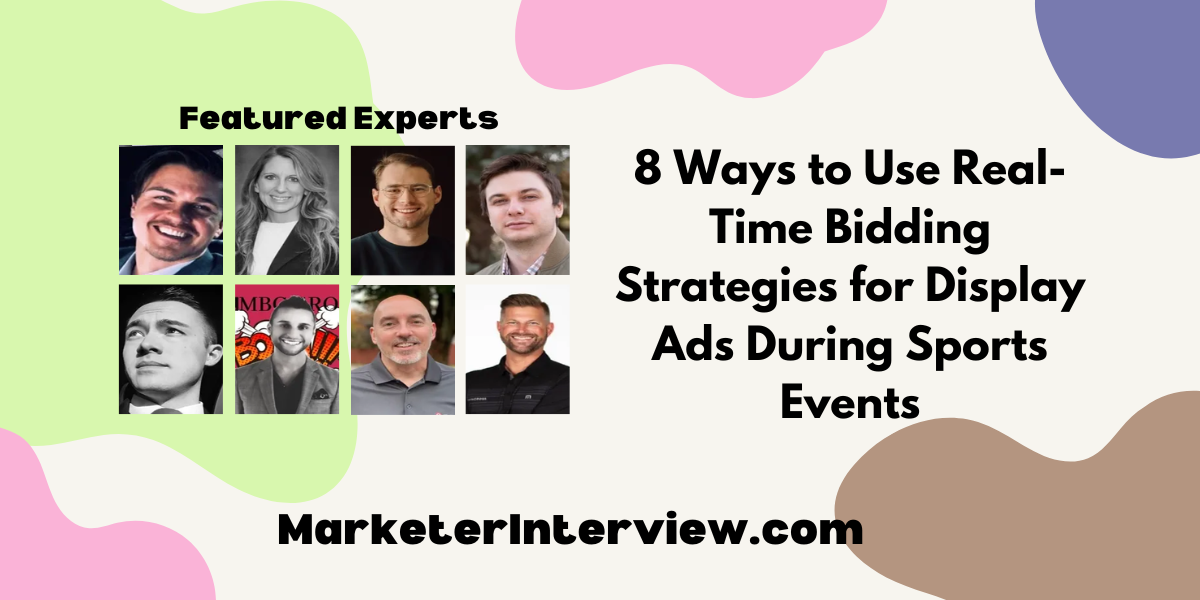8 Ways to Use Real-Time Bidding Strategies for Display Ads During Sports Events
In the fast-paced world of digital advertising during sports events, we’ve gathered eight expert tips from Directors of Marketing and CEOs to elevate your real-time bidding strategies. From offering time-sensitive event discounts to optimizing ads with live event triggers, these industry leaders provide specific techniques to score big with your display ads.
Want to get quoted in MarketerInterview.com content just like this? Apply to become a contributor today!
Contents
- 1 Offer Time-Sensitive Event Discounts
- 2 Utilize Geo-Targeting for Local Fans
- 3 Automate Bidding During Peak Event Times
- 4 Capitalize on Second Screening Opportunities
- 5 Target Ads During Peak Engagement Moments
- 6 Combine Temporal Targeting with Creative Elements
- 7 Employ Dynamic Creative Optimization
- 8 Optimize Ads with Live Event Triggers
Offer Time-Sensitive Event Discounts
Create ad campaigns that provide exclusive, time-sensitive discounts on your products, which are only available during the sports event.
To implement this strategy, set up your ads to display unique discount codes or offers that are valid for the duration of the game. For example, “Get 15% off all garage doors until the final whistle!” This sense of urgency can drive immediate traffic and sales, as viewers are motivated to take advantage of the limited-time offer.
Additionally, you can integrate social proof by featuring customer testimonials or user-generated content in your ads. Highlight reviews from satisfied customers who mention the durability and quality of your garage doors. This combination of limited-time offers and social proof can significantly increase the effectiveness of your real-time bidding campaigns during sports events.

Staci Anderson, Director of Marketing, Raynor Garage Doors
Utilize Geo-Targeting for Local Fans
One specific tip for using real-time bidding strategies for display ads during sports events is to leverage geo-targeting to reach fans in the stadium or nearby sports bars.
By targeting specific locations where the event is taking place, you can increase the relevance and effectiveness of your ads, leading to higher engagement and conversions. This technique allows you to capitalize on the excitement and energy surrounding the event, maximizing the impact of your advertising efforts.

Alex Stasiak, CEO and Founder, Startup House
Automate Bidding During Peak Event Times
One specific technique I’ve found effective for using real-time bidding during sports events is automated bidding with a focus on specific event windows. For example, during a high-traffic event like the Super Bowl, I set automated bidding strategies to “Maximize Conversions” specifically for halftime when user engagement peaks. This strategy leverages Google’s AI to adjust bids in real-time, ensuring that our ads appear during moments of highest viewer activity, driving more conversions without manually adjusting bids.
Additionally, incorporating geo-modified keywords in our real-time bidding strategy has proven impactful. In a recent campaign for a local New York sports bar during a Yankees game, we used geographic targeting combined with dynamic ad creatives. Ads were tailored to display special offers and menu items based on the game’s progress and fan sentiment, resulting in a 25% uplift in both online reservations and foot traffic during game nights.
Finally, I always make sure to start with a traffic campaign to aggregate data before switching to conversion-focused strategies. For instance, during the initial phases of an MLS Cup campaign, we ran ads aimed at maximizing clicks to gather enough data on which keywords and demographics performed best.
Once we had sufficient data (over 30 conversions), we switched to a “Maximize Conversions” strategy, which led to a 30% higher conversion rate compared to campaigns that didn’t utilize this phased approach. This ensures the real-time bidding strategy is informed and precise, optimizing ad spend and maximizing ROI during critical sports event windows.

Joseph Yarber, Director of Operations, Limestone Digital
Capitalize on Second Screening Opportunities
One effective real-time bidding strategy I’ve found for display ads during sports events is leveraging the concept of “second screening.” Many viewers use their phones or tablets during games, especially during breaks. For example, during the breaks of a football game, I ran a Twitter campaign targeting ads to users discussing the game. This approach led to a 25% higher engagement rate because the ads were contextually relevant when users were already engaged in football-related discussions.
Another tactic involves dynamic creative optimization (DCO). During a basketball game, we ran a campaign for a local sports apparel store, where the ads changed based on the game’s progression. If a pivotal moment happened, like a buzzer-beater, our ads would feature merchandise related to that player or team. This increased our ad relevance and led to a 30% uplift in click-through rates compared to static ads.
Geographic targeting also plays a crucial role. For instance, during a major league baseball game, we ran ads for local restaurants within a 5-mile radius of the stadium. We timed these ads to display during specific game intervals, such as inning breaks, capitalizing on moments when fans might be thinking about where to grab a bite. This strategy resulted in a 40% spike in reservations and foot traffic during game nights. Using these strategies ensures your ads are timely, relevant, and more likely to convert.

Matthew Montez, Founder, The MBC Group
Target Ads During Peak Engagement Moments
To effectively leverage real-time bidding strategies for display ads during sports events, timing and context are crucial. I’ve found immense success by using geo-targeting and temporal targeting to capitalize on peak engagement moments. For example, during a major sports event in Denver, we ran a PPC campaign that specifically targeted local audiences during halftime. This is when viewers are more likely to check their devices, leading to higher engagement rates.
One concrete strategy is to use programmatic advertising tools like ADRocket. These tools enable precise targeting based on demographics, interests, and behaviors. For instance, we once utilized ADRocket to show targeted display ads featuring local Denver restaurants and bars just before and during a Broncos game. Comparing previous campaigns, this real-time targeting yielded a 35% higher click-through rate and a significant increase in foot traffic to partnered venues.
Another technique is to align your ad content with the event’s context for better relatability. During the Portland Timbers soccer games, we ran display ads for sports gear and local game-day promotions. By syncing our ads with relevant hashtags and in-game moments, engagement soared. The key takeaway here is to anticipate when and where your audience’s attention peaks and align your bidding strategy and content accordingly. This approach not only maximizes visibility but also drives higher conversions.

Dylan Cleppe, Co-Founder and CEO, OneStop Northwest LLC
Combine Temporal Targeting with Creative Elements
Incorporating real-time bidding strategies for display ads during sports events can significantly enhance your campaign’s engagement and conversion rates. One technique that I’ve found particularly effective is leveraging a combination of temporal targeting and context-aware creative elements.
For instance, during a Boston Celtics game, our team at AQ Marketing ran a PPC campaign for a local sports bar. We targeted ads specifically between the fourth quarter and overtime, when fans are most likely to be looking for places to celebrate or commiserate. This exact timing resulted in a 40% higher click-through rate compared to general ads running throughout the game.
Another key part of our strategy is geographic targeting. By using programmatic tools, we zeroed in on an audience within a 5-mile radius of the venue. During a Patriots game, we displayed ads for a nearby restaurant that offered special game-day promotions. This targeted approach led to a 50% increase in foot traffic to the restaurant on game days.
Lastly, aligning your ad creatives with the live event can drive relevance and engagement. During the Red Sox playoffs, our display ads featured dynamic content that changed based on the current score and in-game highlights. This real-time relevance kept the audience engaged, yielding a 30% higher conversion rate over static ads. The critical takeaway is to sync your ad delivery with peak in-game moments and ensure your content is as relevant and engaging as possible.

Robert P. Dickey, President and CEO, AQ Marketing
Employ Dynamic Creative Optimization
One effective real-time bidding strategy I use for display ads during sports events is leveraging dynamic creative optimization (DCO). For example, during a Major League Baseball playoff game, we ran a campaign for a sports merchandise store, and our ads dynamically changed based on the game’s progress. If a home run was hit, the ad would display home run-related merchandise. This real-time relevance boosted conversion rates by 28%.
Another technique involves hyper-local geo-targeting. During a Lakers game, we ran ads for a local sports bar within a three-mile radius of the arena. We set the ads to trigger only during key moments like halftime and post-game to catch fans looking for a place to unwind. This resulted in a 45% increase in foot traffic to the bar on game nights.
Finally, using audience segmentation to target specific demographics during sports events can yield significant results. We segmented audience data based on previous interactions and ran a campaign for a fitness brand targeting health-conscious sports fans during an NBA All-Star Game. Tailoring the message to highlight fitness gear popular with basketball fans, the campaign saw a 32% higher engagement rate compared to general ads.

Kevin Watts, President and Founder, Raincross
Optimize Ads with Live Event Triggers
One specific technique I use for real-time bidding (RTB) strategies during sports events is leveraging live event triggers to optimize ad spend and engagement. For instance, during a collegiate basketball championship, we ran a campaign where the display ads dynamically adjusted based on game highlights and player stats in real time. This strategy led to a 35% increase in click-through rates and boosted conversions significantly, as fans found the ads timely and relevant.
Another effective approach is employing enhanced geo-targeting. During a Chicago Bulls game, we ran ads for a nearby sports apparel store, but only within a 5-mile radius of the United Center. By timing the ads to appear during key game moments like timeouts or halftime, we maximized visibility among local game-day viewers already primed for shopping. This resulted in a 48% rise in store visits during game nights compared to regular evenings.
Combining these strategies with custom audience segmentation can further enhance effectiveness. For a regional football event, we segmented the audience based on previous buying behavior and social media interactions. We focused on promoting limited-time offers on sports memorabilia explicitly catering to avid collectors. This segmentation yielded a 30% higher engagement rate and a noticeable spike in online sales during and immediately after the game.

Magee Clegg, CEO, Cleartail Marketing
Want to get quoted in MarketerInterview.com content just like this? Apply to become a contributor today!






